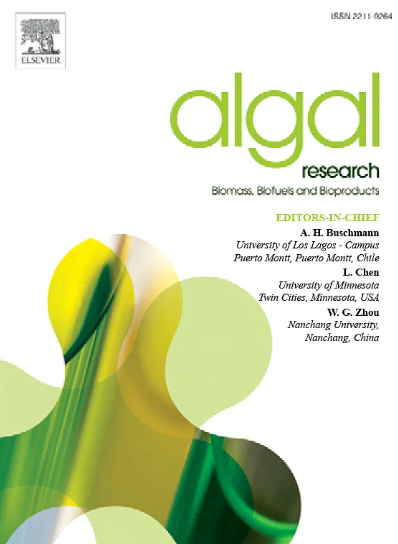通过灰色关联和主成分分析选择植物激素处理对微藻生物活性的影响
IF 4.6
2区 生物学
Q1 BIOTECHNOLOGY & APPLIED MICROBIOLOGY
Algal Research-Biomass Biofuels and Bioproducts
Pub Date : 2025-06-16
DOI:10.1016/j.algal.2025.104152
引用次数: 0
摘要
微藻代表了一种有前途的可持续的高价值化合物来源,包括类胡萝卜素和omega-3脂肪酸,这些化合物在保健品、药品、化妆品和功能食品中都有应用。褐藻黄素是一种叶黄素类胡萝卜素,具有抗肥胖、抗糖尿病、抗氧化和抗炎的特性,而像二十二碳六烯酸(DHA)和二十碳五烯酸(EPA)这样的omega-3脂肪酸是对水产养殖和人类健康特别重要的必需营养素。然而,商业化生产面临着生产率低和加工成本高的挑战。本研究旨在评估12种植物激素(生长素、细胞分解素、赤霉素、脱落酸、茉莉酸盐和水杨酸)对三种生物技术相关微藻(Chrysochromulina rotalis、Heterosigma akashiwo和Entomoneis sp)的生物量生产力、岩藻黄素含量和脂肪酸谱的影响。植物激素的浓度范围为0.5-30 mg L - 1(乙醇胺为100 mg L - 1)。灰色关联分析(GRA)和主成分分析(PCA)显示了物种特异性的最佳处理:水杨酸(30 mg L−1)可使圆顶藻增加43%的岩藻黄质和36%的omega-3脂肪酸;赤石麻的赤霉素酸(30mg L−1)使岩藻黄质提高27%,使EPA提高25%;6-苄基氨基嘌呤(15 mg L - 1)可使褐藻黄质增加34%,总脂肪酸增加28%。这些处理在生物量生产力和高价值代谢物积累方面均有显著改善,具有潜在的成本效益。这些改善的分子机制涉及激素信号通路、初级代谢和次级代谢物合成之间复杂的相互作用。进一步探索废水来源的植物激素可以降低生产成本,提高微藻生物工艺的可持续性。本文章由计算机程序翻译,如有差异,请以英文原文为准。

Selecting phytohormone treatments through Grey Relational and Principal Component Analysis for microalgal bioactives production
Microalgae represent a promising sustainable source of high-value compounds including carotenoids and omega-3 fatty acids, which have applications in nutraceuticals, pharmaceuticals, cosmetics, and functional foods. Fucoxanthin, a xanthophyll carotenoid, exhibits anti-obesity, antidiabetic, antioxidant, and anti-inflammatory properties, while omega-3 fatty acids like docosahexaenoic acid (DHA) and eicosapentaenoic acid (EPA) are essential nutrients particularly important in aquaculture and human health. However, commercial production faces challenges including low productivity and high processing costs. This study aimed to evaluate the effects of twelve phytohormones (auxins, cytokinins, gibberellins, abscisic acid, jasmonates, and salicylic acid) on biomass productivity, fucoxanthin content, and fatty acid profiles of three biotechnologically relevant microalgae: Chrysochromulina rotalis, Heterosigma akashiwo, and Entomoneis sp. Phytohormones were tested at concentrations in the range 0.5–30 mg L−1 (100 mg L−1 in the case of ethanolamine). Grey Relational Analysis (GRA) and Principal Component Analysis (PCA) revealed species-specific optimal treatments: salicylic acid (30 mg L−1) for C. rotalis increased fucoxanthin by 43 % and omega-3 fatty acids by 36 %; gibberellic acid (30 mg L−1) for H. akashiwo improved fucoxanthin by 27 % and EPA by 25 %; and 6-benzylaminopurine (15 mg L−1) for Entomoneis sp. enhanced fucoxanthin by 34 % and total fatty acids by 28 %. These treatments demonstrated significant improvements in both biomass productivity and high-value metabolite accumulation with potential cost-effectiveness. The molecular mechanisms underlying these improvements involve complex interactions between hormone signaling pathways, primary metabolism, and secondary metabolite synthesis. Further exploration of wastewater-derived phytohormones could reduce production costs and enhance sustainability in microalgae-based bioprocesses.
求助全文
通过发布文献求助,成功后即可免费获取论文全文。
去求助
来源期刊

Algal Research-Biomass Biofuels and Bioproducts
BIOTECHNOLOGY & APPLIED MICROBIOLOGY-
CiteScore
9.40
自引率
7.80%
发文量
332
期刊介绍:
Algal Research is an international phycology journal covering all areas of emerging technologies in algae biology, biomass production, cultivation, harvesting, extraction, bioproducts, biorefinery, engineering, and econometrics. Algae is defined to include cyanobacteria, microalgae, and protists and symbionts of interest in biotechnology. The journal publishes original research and reviews for the following scope: algal biology, including but not exclusive to: phylogeny, biodiversity, molecular traits, metabolic regulation, and genetic engineering, algal cultivation, e.g. phototrophic systems, heterotrophic systems, and mixotrophic systems, algal harvesting and extraction systems, biotechnology to convert algal biomass and components into biofuels and bioproducts, e.g., nutraceuticals, pharmaceuticals, animal feed, plastics, etc. algal products and their economic assessment
 求助内容:
求助内容: 应助结果提醒方式:
应助结果提醒方式:


